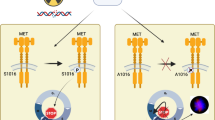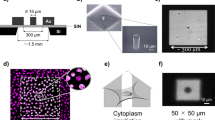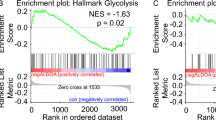Abstract
Mutations in the gene ATM are responsible for the genetic disorder ataxia-telangiectasia (A-T), which is characterized by cerebellar dysfunction, radiosensitivity, chromosomal instability and cancer predisposition. Both the A-T phenotype and the similarity of the ATM protein to other DNA-damage sensors suggests a role for ATM in biochemical pathways involved in the recognition, signalling and repair of DNA double-strand breaks (DSBs). There are strong parallels between the pattern of radiosensitivity, chromosomal instability and cancer predisposition in A-T patients and that in patients with Nijmegen breakage syndrome (NBS). The protein defective in NBS, nibrin (encoded by NBS1), forms a complex with MRE11 and RAD50 (refs 1,2). This complex localizes to DSBs within 30 minutes after cellular exposure to ionizing radiation (IR) and is observed in brightly staining nuclear foci after a longer period of time3. The overlap between clinical and cellular phenotypes in A-T and NBS suggests that ATM and nibrin may function in the same biochemical pathway. Here we demonstrate that nibrin is phosphorylated within one hour of treatment of cells with IR. This response is abrogated in A-T cells that either do not express ATM protein or express near full-length mutant protein. We also show that ATM physically interacts with and phosphorylates nibrin on serine 343 both in vivo and in vitro. Phosphorylation of this site appears to be functionally important because mutated nibrin (S343A) does not completely complement radiosensitivity in NBS cells. ATM phosphorylation of nibrin does not affect nibrin-MRE11-RAD50 association as revealed by radiation-induced foci formation. Our data provide a biochemical explanation for the similarity in phenotype between A-T and NBS.
This is a preview of subscription content, access via your institution
Access options
Subscribe to this journal
Receive 12 print issues and online access
$209.00 per year
only $17.42 per issue
Buy this article
- Purchase on Springer Link
- Instant access to full article PDF
Prices may be subject to local taxes which are calculated during checkout




Similar content being viewed by others
References
Carney, J.P. et al. The hMre11/hRad50 protein complex and Nijmegen breakage syndrome: linkage of double-strand break repair to the cellular DNA damage response. Cell 93, 477–486 (1998).
Varon, R. et al. Nibrin, a novel DNA double-strand break repair protein, is mutated in Nijmegen breakage syndrome. Cell 93, 467–476 (1998).
Nelms, B.E., Maser, R.S., MacKay, J.F., Lagally, M.G. & Petrini, J.H. In situ visualization of DNA double-strand break repair in human fibroblasts. Science 280, 590–592 (1998).
Zhang, N. et al. Isolation of full-length ATM cDNA and correction of the ataxia-telangiectasia cellular phenotype. Proc. Natl Acad. Sci. USA 94, 8021–8026 (1997).
Khanna, K.K. et al. ATM associates with and phosphorylates p53: mapping the region of interaction. Nature Genet 20, 398–400 (1998).
Canman, C.E. et al. Activation of the ATM kinase by ionizing radiation and phosphorylation of p53. Science 281, 1677–1679 (1998).
Banin, S. et al. Enhanced phosphorylation of p53 by ATM in response to DNA damage. Science 281, 1674–1677 (1998).
Savitsky, K. et al. A single ataxia telangiectasia gene with a product similar to PI-3 kinase. Science 268, 1749–1753 (1995).
Shafman, T. et al. Interaction between ATM protein and c-Abl in response to DNA damage. Nature 387, 520–523 (1997).
Baskaran, R. et al. Ataxia telangiectasia mutant protein activates c-Abl tyrosine kinase in response to ionizing radiation. Nature 387, 516–519 (1997).
Kim, S.-T. et al. Substrate specificities and identification of putative substrates of ATM kinase family members. J. Biol. Chem. 274, 37538–37543 (1999).
Cortez, D., Wang, Y., Qin, J. & Elledge, S.J. Requirement of ATM-dependent phosphorylation of brca1 in the DNA damage response to double-strand breaks. Science 286, 1162–1166 (1999).
Gatei, M. et al. A role for ATM in damage-induced phosphorylation of BRCA1. Cancer Res. (in press).
Stewart, G.S. et al. The DNA double-strand break repair gene hMRE11 is mutated in individuals with an ataxia-telangiectasia-like disorder. Cell 99, 577–587 (1999).
Watters, D. et al. Cellular localisation of the ataxia-telangiectasia (ATM) gene product and discrimination between mutated and normal forms. Oncogene 14, 1911–1921 (1997).
Frangioni, J.V. & Neel, B.G. Solubilization and purification of enzymatically active glutathione S-transferase (pGEX) fusion proteins. Anal. Biochem. 210, 179–187 (1993).
Pear, W.S., Scott, M.L. & Nolan, G.P. Generation of High Titre, Helper-free Retroviruses by Transient Transfection 41–57 (Humana Press, Totowa, NJ, 1996).
Wright, J.A. et al. Protein kinase mutants of human ATR increase sensitivity to UV and ionizing radiation and abrogate cell cycle checkpoint control. Proc. Natl Acad. Sci. USA 95, 7445–7450 (1998).
Ziv, Y. et al. Recombinant ATM protein complements the cellular A-T phenotype. Oncogene 15, 159–167 (1997).
Acknowledgements
We thank S. Scott for helpful discussion and photographic assistance, and K. Hobson for assistance with tissue culture. Financial support was provided by the National Health and Medical Research Council of Australia, The Queensland Cancer Fund, the National Cancer Institute (CA57569) and the A-T Medical Research Foundation.
Author information
Authors and Affiliations
Corresponding author
Rights and permissions
About this article
Cite this article
Gatei, M., Young, D., Cerosaletti, K. et al. ATM-dependent phosphorylation of nibrin in response to radiation exposure. Nat Genet 25, 115–119 (2000). https://doi.org/10.1038/75508
Received:
Accepted:
Issue Date:
DOI: https://doi.org/10.1038/75508
This article is cited by
-
RNA and phosphoprotein profiles of TP53- and PTEN-knockouts in MCF10A at baseline and responding to DNA damage
Scientific Data (2024)
-
First international workshop of the ATM and cancer risk group (4-5 December 2019)
Familial Cancer (2022)
-
Analysis of exosomal circRNAs upon irradiation in pancreatic cancer cell repopulation
BMC Medical Genomics (2020)
-
DNA damage response signaling pathways and targets for radiotherapy sensitization in cancer
Signal Transduction and Targeted Therapy (2020)
-
NBS1 interacts with HP1 to ensure genome integrity
Cell Death & Disease (2019)



